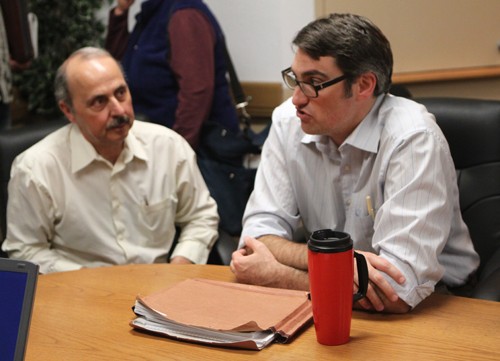Homeowners who want to preserve Jefferson Park neighborhood and developers looking to build new houses tailored to students argued on Wednesday.
Members of the Jefferson Park Neighborhood Design Manual Advisory Board and staff from the City of Tucson met at Waverly Park Healthcare Center to discuss the latest draft of the neighborhood’s preservation manual. The manual seeks to prevent the building of “”mini-dorms,”” or large, multiple-bedroom houses that are architecturally incompatible with the rest of the neighborhood.
These “”mini-dorms”” are often rented to students and can include up to nine bedrooms.
Some residents said the issue is incorrectly labeled as a controversy against students by developers.
“”What we have here is a historic neighborhood. What we’re trying to preserve is a historic neighborhood and a single-family neighborhood,”” said Nancy Martin, a member of the advisory board and Jefferson Park homeowner.
Martin said she has neighbors who are students, but has no problem with them living in the original two-bedroom houses.
“”We are not trying to legislate against students,”” Martin said. “”This is about architecture. Architecture is destiny in this neighborhood.””
Staff from the City of Tucson wrote the manual to make sure it follows the guidelines of the preservation ordinance and is legally defendable, said Adam Smith, principal planner for the City of Tucson Planning and Development Services Department. Main changes to the draft included requirements for front yards, massing, scale and architectural design of new construction and renovations.
Smith said the revisions were a “”balancing act”” between the input of homeowners and developers.
“”We attempted to come up with a recommendation that was fair, reasonable and implementable,”” Smith said. “”We tried to listen to everybody’s opinion, so not just the neighborhood and not just the developers.””
“”Mini-dorms”” are often identifiable as multi-story. The new draft raised the “”maximum residential floor to area ratio”” from 0.35, which was suggested by homeowners, to 0.4. This would allow for houses to be remodeled larger on the lot to accommodate more people, or in this case student residents. The change was problematic for some members of the committee.
“”I want you to understand how very serious this is to us and how we are, and I think I can speak for many people in this room, enraged about this jump-up,”” said Lisa Jones, a member of the advisory board and Jefferson Park homeowner.
Some homeowners said the ratio will not sufficiently limit the construction of “”mini-dorms.””
“”That makes no sense, no sense at all,”” said Suzanne Trappman, a member of the advisory board and a Jefferson Park homeowner. “”That’s what we’re trying to stop so that we don’t have a lot of density. For one reason, the infrastructure can’t support a lot of density.””
Some developers saw the increase in ratio as an attempt to protect the rights of property owners.
“”I’m still not happy with what’s happening because when you bought your property, you had certain rights that were in writing,”” said Mike Goodman, a developer in the neighborhood. “”When I bought my property, I received certain rights that were in writing. They were established. They were codified. What you’re asking, you’re asking them to take away those rights, to minimize those rights of what we see as fit to do with our property. Without that, where is the compromise?””
The new draft also added a requirement for privacy mitigation. Two-story houses with balconies will be required to shield visibility into neighboring yards.
Local developer John Lee said the various restrictions in the manual make it difficult for him to improve his properties, even in ways that are appropriate for the neighborhood.
“”The properties I own, I want to improve them,”” Lee said. “”I don’t want to preserve them exactly the way they are. That’s why I bought them.””









